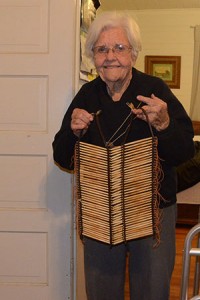
Showing a breastplate worn by her uncle Herman Lehmann while he lived and fought with the Apache and Comanche, Esther Lehmann is the last link to a Native American captive. Photo by Phil Houseal
by Phil Houseal
Jan 8, 2014
History from a distance is a textbook.
But when it sits across the table from you, speaks to you, and lets you touch the rawhide sinews that bridge two centuries, history lives.
So the tale unfolded as I spent an afternoon at the Sunday House of Esther Lehmann, the last and only person who has lived with a captive of the Native Americans.
Esther is the daughter of Willie Lehmann and the niece of Herman Lehmann. Even casual Texas history fans know the story of their capture by Apaches in 1870.
Brothers Willie and Herman, ages 8 and 10, were taken from their family’s farm near Loyal Valley one afternoon by a tribe of Lipans. Willie managed to escape a few days later, but Herman stayed with the Indians for 8 years. Herman returned to the white world when he was 19, after living with the Apache and Comanche, battling Texas Rangers, and becoming part of Quanah Parker’s family.
When Herman came back to Loyal Valley around 1927 to live with his brother, Esther was 3 1/2 years old. For the next 5 years, until Herman’s death in 1932, Esther sat at his side by the fireplace in their two-room home and listened wide-eyed to his stories of living with the Indians.
“I spent much time sitting by him, talking in this loud voice,” explained Esther, now aged 90. “I talked, and he went ‘Huh?’ In my old age I found out ‘huh’ meant ’yes’ in the Comanche language. The whole time my voice was getting louder and louder.” She laughed at the memory.
Esther tells such stories with relish, polished from repetition for the many people around the world who continue to be fascinated by the tale of the white man who lived with Indians.
While I went to hear Herman’s tale, I soon learned the story was as much about Esther, a frontier cowgirl who grew up in the spirit of the 19th century.
Her father worked one of the last cattle drives on the Old Chisholm Trail, and according to his youngest daughter, drove his own children harder than he drove cattle.
“Daddy had the patience of Job with cattle, but none with his kids,” Esther remembered. “When he said jump, you jumped. I helped him drive cattle many a time, and he never rushed them. I can hear him to this day, saying give ‘em time, let ‘em graze, don’t rush ‘em.”
She never took much to cooking and sewing that her mother tried to teach her. She was more of an outdoor girl, more comfortable spurring a horse than pumping a sewing machine.
“I spent my life on back of horse. We rode 10 miles a day on horseback. We didn’t know what a pickup was. I was a real cowgirl.”
She milked their small herd of Herefords, picked vegetables from their 2-acre garden, canned everything, and helped butcher beef, hogs, and the steady supply of deer meat so loved by her Indian uncle.
“He hunted for deer all the time, with bow and arrow and later on with a gun. I’ll say this now…” She lowered her voice in a conspiratorial whisper. “It didn’t matter if it was deer season or not. When we ran out of jerky he’d go kill a deer. We’d sneak it down to the cellar, and hang it to dry from the rafters.”
Herman continued habits he picked up from his years with the Comanche and Apache. Esther remembers him eating his deer meat raw, ground up with onion and salt and pepper and slathered on butter bread. He would disappear for days at a time. Sometimes it was a trip back to the Oklahoma reservation, where he would visit with his family and friends.
“Sometimes he would just go out in woods and reminisce about his life with the Indians,” she said with a touch of sadness. “He loved that life.”
Next Week: Memories happy and sad